Elevator Pitches & Case Discussions in Contemporary Strategy
VerifiedAdded on 2023/06/11
|8
|2123
|302
Report
AI Summary
This report focuses on applying strategic management principles through online conversations, specifically using elevator pitches and case discussion activities. It addresses the importance of organizational planning, particularly in the VUCA (Volatile, Uncertain, Complex, Ambiguous) world. The report includes elevator pitch responses and case discussion activity responses, covering topics such as responsiveness to customer needs, service quality, market research, conflict resolution, and the adoption of visionary strategies. It also discusses the five forces analysis (threat of new entry, threat of substitutes, buyers' bargaining power, suppliers' bargaining power, and competitive rivalry) and the importance of understanding organizational strengths and weaknesses. The report concludes by emphasizing the significance of managing people through their hands, hearts, and minds, and the need to address key management problems to achieve organizational goals. Desklib offers a wide array of solved assignments and study resources for students.
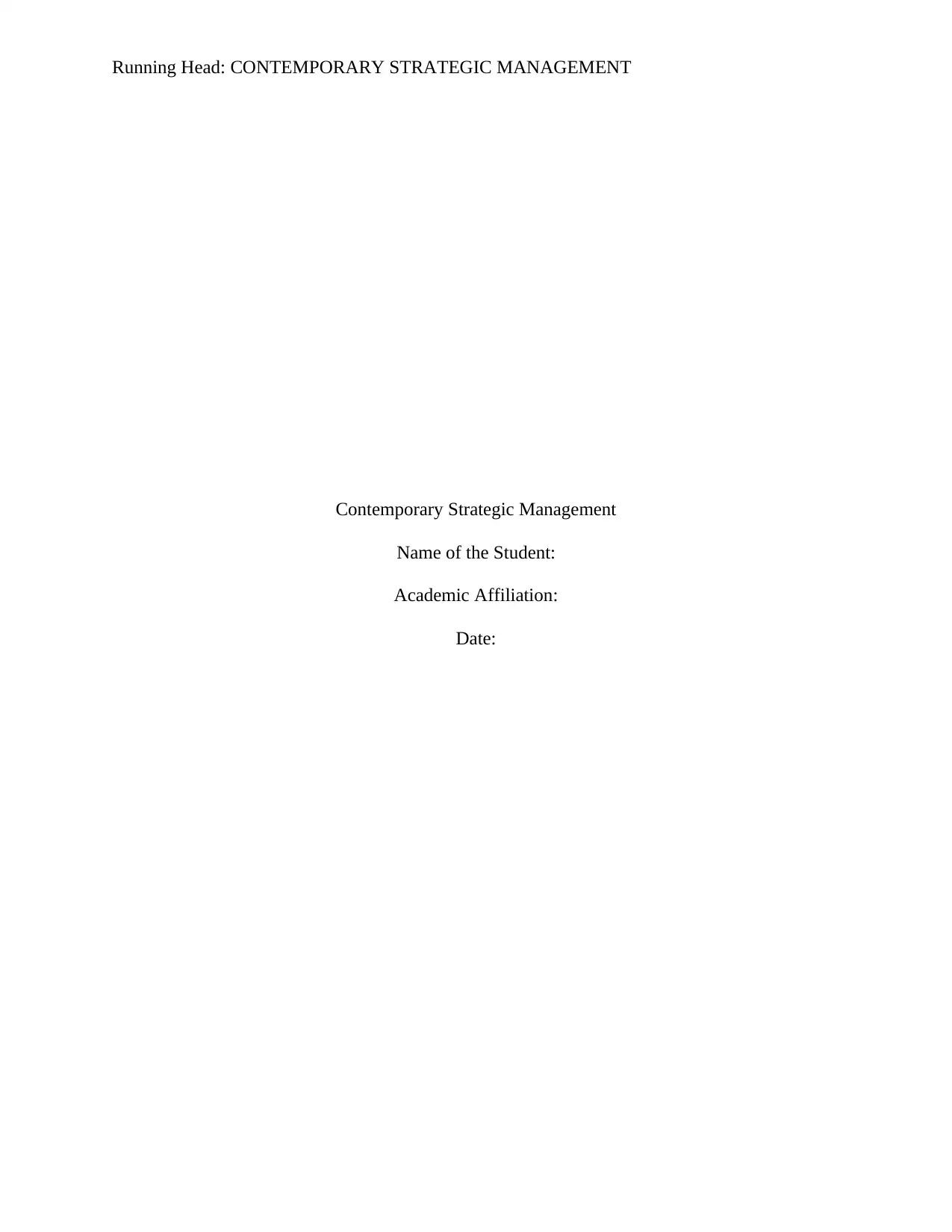
Running Head: CONTEMPORARY STRATEGIC MANAGEMENT
Contemporary Strategic Management
Name of the Student:
Academic Affiliation:
Date:
Contemporary Strategic Management
Name of the Student:
Academic Affiliation:
Date:
Paraphrase This Document
Need a fresh take? Get an instant paraphrase of this document with our AI Paraphraser
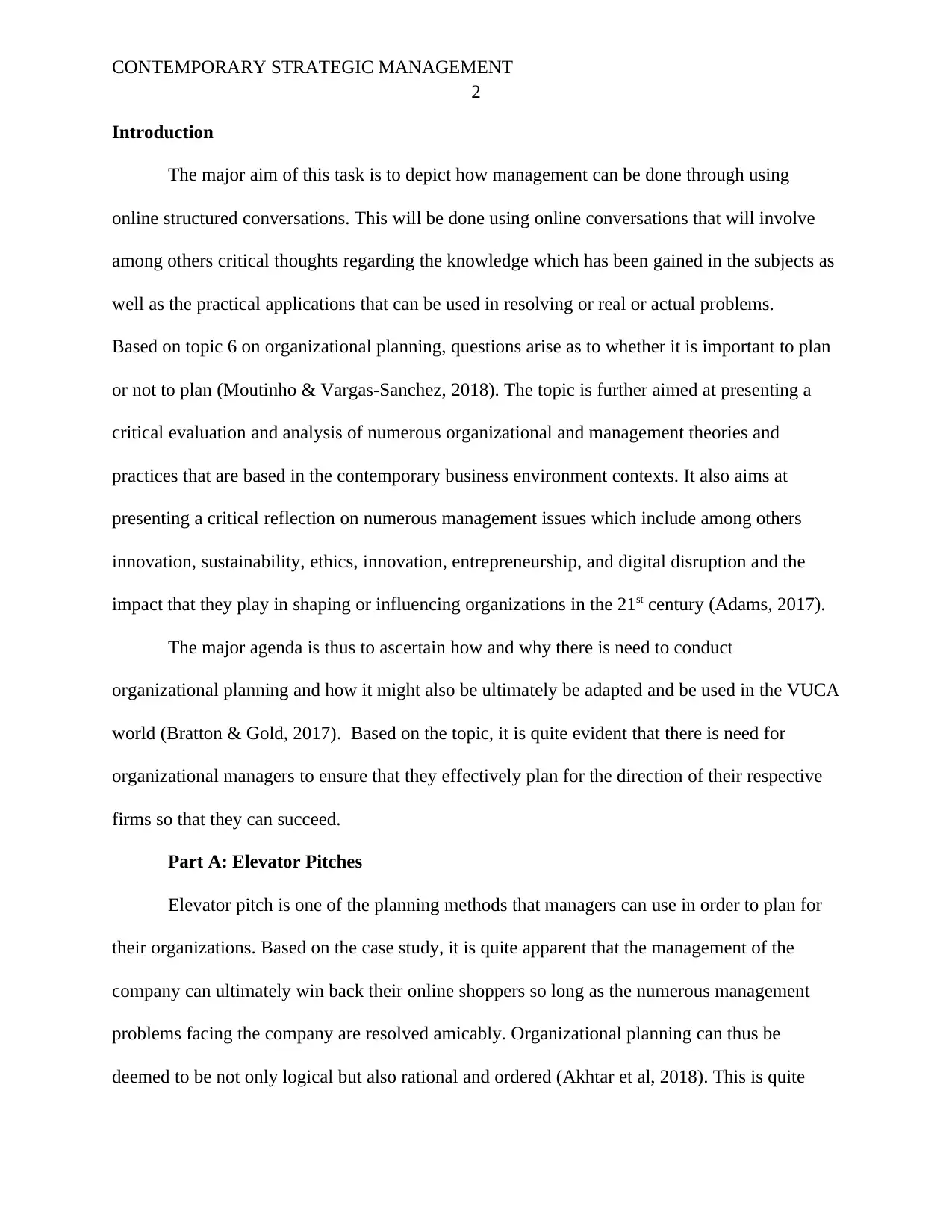
CONTEMPORARY STRATEGIC MANAGEMENT
2
Introduction
The major aim of this task is to depict how management can be done through using
online structured conversations. This will be done using online conversations that will involve
among others critical thoughts regarding the knowledge which has been gained in the subjects as
well as the practical applications that can be used in resolving or real or actual problems.
Based on topic 6 on organizational planning, questions arise as to whether it is important to plan
or not to plan (Moutinho & Vargas-Sanchez, 2018). The topic is further aimed at presenting a
critical evaluation and analysis of numerous organizational and management theories and
practices that are based in the contemporary business environment contexts. It also aims at
presenting a critical reflection on numerous management issues which include among others
innovation, sustainability, ethics, innovation, entrepreneurship, and digital disruption and the
impact that they play in shaping or influencing organizations in the 21st century (Adams, 2017).
The major agenda is thus to ascertain how and why there is need to conduct
organizational planning and how it might also be ultimately be adapted and be used in the VUCA
world (Bratton & Gold, 2017). Based on the topic, it is quite evident that there is need for
organizational managers to ensure that they effectively plan for the direction of their respective
firms so that they can succeed.
Part A: Elevator Pitches
Elevator pitch is one of the planning methods that managers can use in order to plan for
their organizations. Based on the case study, it is quite apparent that the management of the
company can ultimately win back their online shoppers so long as the numerous management
problems facing the company are resolved amicably. Organizational planning can thus be
deemed to be not only logical but also rational and ordered (Akhtar et al, 2018). This is quite
2
Introduction
The major aim of this task is to depict how management can be done through using
online structured conversations. This will be done using online conversations that will involve
among others critical thoughts regarding the knowledge which has been gained in the subjects as
well as the practical applications that can be used in resolving or real or actual problems.
Based on topic 6 on organizational planning, questions arise as to whether it is important to plan
or not to plan (Moutinho & Vargas-Sanchez, 2018). The topic is further aimed at presenting a
critical evaluation and analysis of numerous organizational and management theories and
practices that are based in the contemporary business environment contexts. It also aims at
presenting a critical reflection on numerous management issues which include among others
innovation, sustainability, ethics, innovation, entrepreneurship, and digital disruption and the
impact that they play in shaping or influencing organizations in the 21st century (Adams, 2017).
The major agenda is thus to ascertain how and why there is need to conduct
organizational planning and how it might also be ultimately be adapted and be used in the VUCA
world (Bratton & Gold, 2017). Based on the topic, it is quite evident that there is need for
organizational managers to ensure that they effectively plan for the direction of their respective
firms so that they can succeed.
Part A: Elevator Pitches
Elevator pitch is one of the planning methods that managers can use in order to plan for
their organizations. Based on the case study, it is quite apparent that the management of the
company can ultimately win back their online shoppers so long as the numerous management
problems facing the company are resolved amicably. Organizational planning can thus be
deemed to be not only logical but also rational and ordered (Akhtar et al, 2018). This is quite
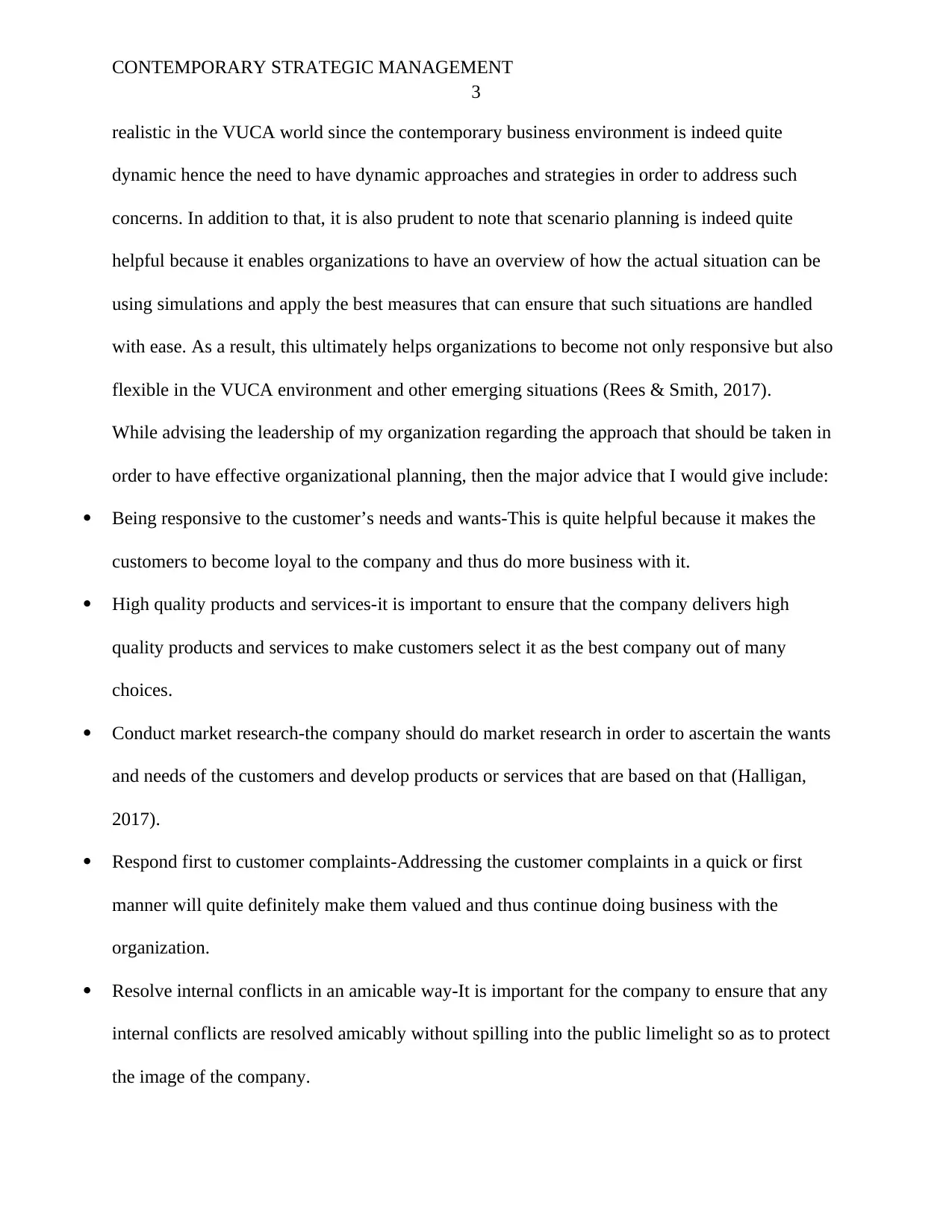
CONTEMPORARY STRATEGIC MANAGEMENT
3
realistic in the VUCA world since the contemporary business environment is indeed quite
dynamic hence the need to have dynamic approaches and strategies in order to address such
concerns. In addition to that, it is also prudent to note that scenario planning is indeed quite
helpful because it enables organizations to have an overview of how the actual situation can be
using simulations and apply the best measures that can ensure that such situations are handled
with ease. As a result, this ultimately helps organizations to become not only responsive but also
flexible in the VUCA environment and other emerging situations (Rees & Smith, 2017).
While advising the leadership of my organization regarding the approach that should be taken in
order to have effective organizational planning, then the major advice that I would give include:
Being responsive to the customer’s needs and wants-This is quite helpful because it makes the
customers to become loyal to the company and thus do more business with it.
High quality products and services-it is important to ensure that the company delivers high
quality products and services to make customers select it as the best company out of many
choices.
Conduct market research-the company should do market research in order to ascertain the wants
and needs of the customers and develop products or services that are based on that (Halligan,
2017).
Respond first to customer complaints-Addressing the customer complaints in a quick or first
manner will quite definitely make them valued and thus continue doing business with the
organization.
Resolve internal conflicts in an amicable way-It is important for the company to ensure that any
internal conflicts are resolved amicably without spilling into the public limelight so as to protect
the image of the company.
3
realistic in the VUCA world since the contemporary business environment is indeed quite
dynamic hence the need to have dynamic approaches and strategies in order to address such
concerns. In addition to that, it is also prudent to note that scenario planning is indeed quite
helpful because it enables organizations to have an overview of how the actual situation can be
using simulations and apply the best measures that can ensure that such situations are handled
with ease. As a result, this ultimately helps organizations to become not only responsive but also
flexible in the VUCA environment and other emerging situations (Rees & Smith, 2017).
While advising the leadership of my organization regarding the approach that should be taken in
order to have effective organizational planning, then the major advice that I would give include:
Being responsive to the customer’s needs and wants-This is quite helpful because it makes the
customers to become loyal to the company and thus do more business with it.
High quality products and services-it is important to ensure that the company delivers high
quality products and services to make customers select it as the best company out of many
choices.
Conduct market research-the company should do market research in order to ascertain the wants
and needs of the customers and develop products or services that are based on that (Halligan,
2017).
Respond first to customer complaints-Addressing the customer complaints in a quick or first
manner will quite definitely make them valued and thus continue doing business with the
organization.
Resolve internal conflicts in an amicable way-It is important for the company to ensure that any
internal conflicts are resolved amicably without spilling into the public limelight so as to protect
the image of the company.
⊘ This is a preview!⊘
Do you want full access?
Subscribe today to unlock all pages.

Trusted by 1+ million students worldwide
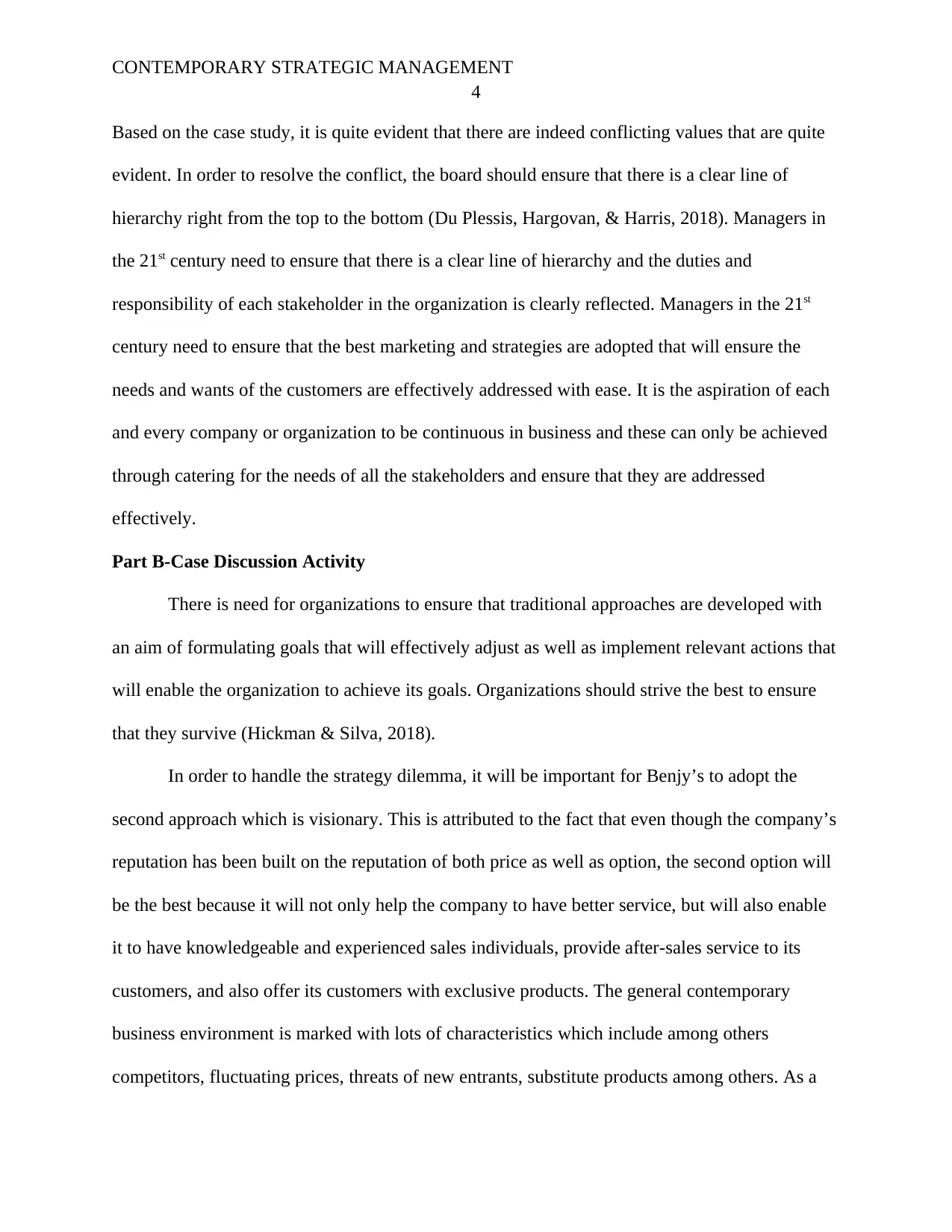
CONTEMPORARY STRATEGIC MANAGEMENT
4
Based on the case study, it is quite evident that there are indeed conflicting values that are quite
evident. In order to resolve the conflict, the board should ensure that there is a clear line of
hierarchy right from the top to the bottom (Du Plessis, Hargovan, & Harris, 2018). Managers in
the 21st century need to ensure that there is a clear line of hierarchy and the duties and
responsibility of each stakeholder in the organization is clearly reflected. Managers in the 21st
century need to ensure that the best marketing and strategies are adopted that will ensure the
needs and wants of the customers are effectively addressed with ease. It is the aspiration of each
and every company or organization to be continuous in business and these can only be achieved
through catering for the needs of all the stakeholders and ensure that they are addressed
effectively.
Part B-Case Discussion Activity
There is need for organizations to ensure that traditional approaches are developed with
an aim of formulating goals that will effectively adjust as well as implement relevant actions that
will enable the organization to achieve its goals. Organizations should strive the best to ensure
that they survive (Hickman & Silva, 2018).
In order to handle the strategy dilemma, it will be important for Benjy’s to adopt the
second approach which is visionary. This is attributed to the fact that even though the company’s
reputation has been built on the reputation of both price as well as option, the second option will
be the best because it will not only help the company to have better service, but will also enable
it to have knowledgeable and experienced sales individuals, provide after-sales service to its
customers, and also offer its customers with exclusive products. The general contemporary
business environment is marked with lots of characteristics which include among others
competitors, fluctuating prices, threats of new entrants, substitute products among others. As a
4
Based on the case study, it is quite evident that there are indeed conflicting values that are quite
evident. In order to resolve the conflict, the board should ensure that there is a clear line of
hierarchy right from the top to the bottom (Du Plessis, Hargovan, & Harris, 2018). Managers in
the 21st century need to ensure that there is a clear line of hierarchy and the duties and
responsibility of each stakeholder in the organization is clearly reflected. Managers in the 21st
century need to ensure that the best marketing and strategies are adopted that will ensure the
needs and wants of the customers are effectively addressed with ease. It is the aspiration of each
and every company or organization to be continuous in business and these can only be achieved
through catering for the needs of all the stakeholders and ensure that they are addressed
effectively.
Part B-Case Discussion Activity
There is need for organizations to ensure that traditional approaches are developed with
an aim of formulating goals that will effectively adjust as well as implement relevant actions that
will enable the organization to achieve its goals. Organizations should strive the best to ensure
that they survive (Hickman & Silva, 2018).
In order to handle the strategy dilemma, it will be important for Benjy’s to adopt the
second approach which is visionary. This is attributed to the fact that even though the company’s
reputation has been built on the reputation of both price as well as option, the second option will
be the best because it will not only help the company to have better service, but will also enable
it to have knowledgeable and experienced sales individuals, provide after-sales service to its
customers, and also offer its customers with exclusive products. The general contemporary
business environment is marked with lots of characteristics which include among others
competitors, fluctuating prices, threats of new entrants, substitute products among others. As a
Paraphrase This Document
Need a fresh take? Get an instant paraphrase of this document with our AI Paraphraser
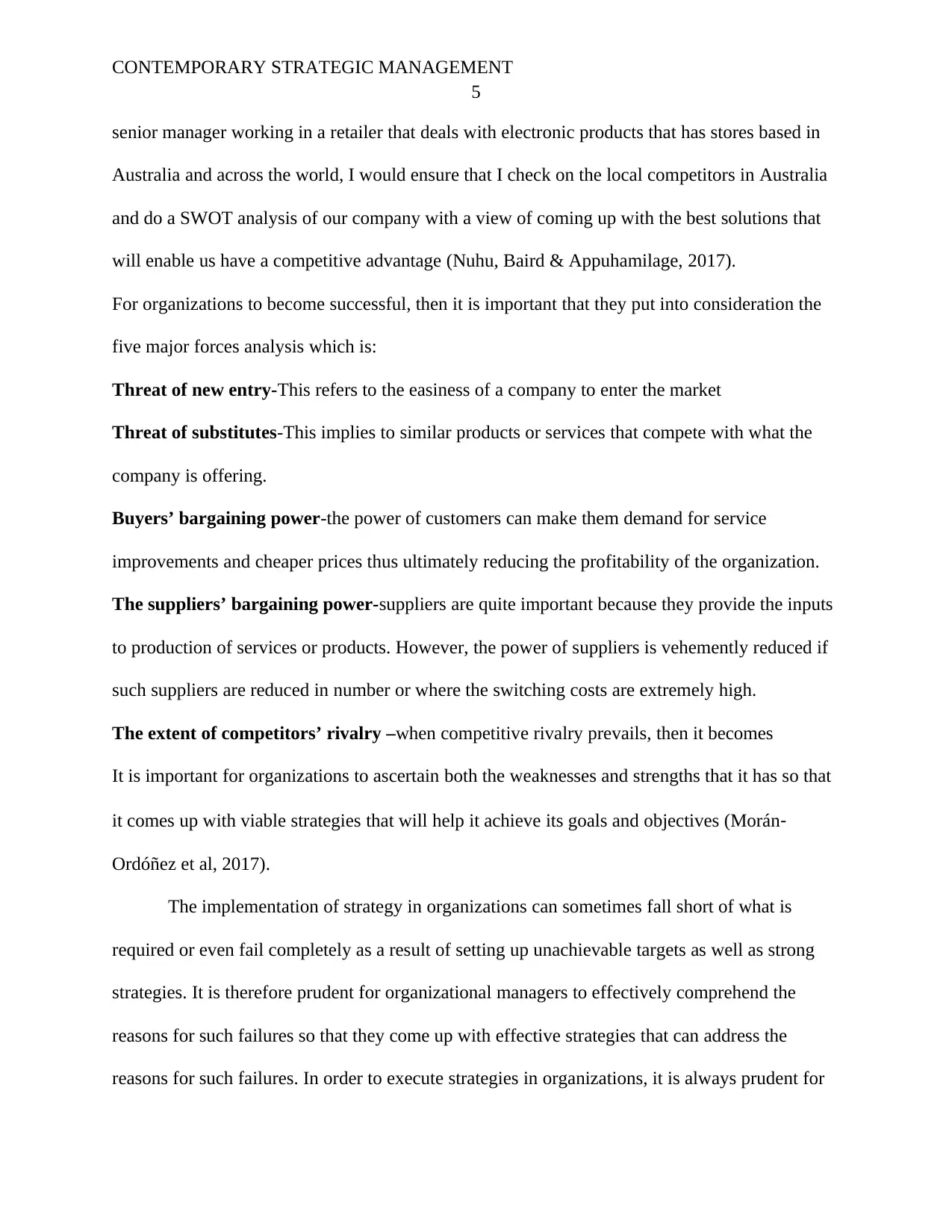
CONTEMPORARY STRATEGIC MANAGEMENT
5
senior manager working in a retailer that deals with electronic products that has stores based in
Australia and across the world, I would ensure that I check on the local competitors in Australia
and do a SWOT analysis of our company with a view of coming up with the best solutions that
will enable us have a competitive advantage (Nuhu, Baird & Appuhamilage, 2017).
For organizations to become successful, then it is important that they put into consideration the
five major forces analysis which is:
Threat of new entry-This refers to the easiness of a company to enter the market
Threat of substitutes-This implies to similar products or services that compete with what the
company is offering.
Buyers’ bargaining power-the power of customers can make them demand for service
improvements and cheaper prices thus ultimately reducing the profitability of the organization.
The suppliers’ bargaining power-suppliers are quite important because they provide the inputs
to production of services or products. However, the power of suppliers is vehemently reduced if
such suppliers are reduced in number or where the switching costs are extremely high.
The extent of competitors’ rivalry –when competitive rivalry prevails, then it becomes
It is important for organizations to ascertain both the weaknesses and strengths that it has so that
it comes up with viable strategies that will help it achieve its goals and objectives (Morán‐
Ordóñez et al, 2017).
The implementation of strategy in organizations can sometimes fall short of what is
required or even fail completely as a result of setting up unachievable targets as well as strong
strategies. It is therefore prudent for organizational managers to effectively comprehend the
reasons for such failures so that they come up with effective strategies that can address the
reasons for such failures. In order to execute strategies in organizations, it is always prudent for
5
senior manager working in a retailer that deals with electronic products that has stores based in
Australia and across the world, I would ensure that I check on the local competitors in Australia
and do a SWOT analysis of our company with a view of coming up with the best solutions that
will enable us have a competitive advantage (Nuhu, Baird & Appuhamilage, 2017).
For organizations to become successful, then it is important that they put into consideration the
five major forces analysis which is:
Threat of new entry-This refers to the easiness of a company to enter the market
Threat of substitutes-This implies to similar products or services that compete with what the
company is offering.
Buyers’ bargaining power-the power of customers can make them demand for service
improvements and cheaper prices thus ultimately reducing the profitability of the organization.
The suppliers’ bargaining power-suppliers are quite important because they provide the inputs
to production of services or products. However, the power of suppliers is vehemently reduced if
such suppliers are reduced in number or where the switching costs are extremely high.
The extent of competitors’ rivalry –when competitive rivalry prevails, then it becomes
It is important for organizations to ascertain both the weaknesses and strengths that it has so that
it comes up with viable strategies that will help it achieve its goals and objectives (Morán‐
Ordóñez et al, 2017).
The implementation of strategy in organizations can sometimes fall short of what is
required or even fail completely as a result of setting up unachievable targets as well as strong
strategies. It is therefore prudent for organizational managers to effectively comprehend the
reasons for such failures so that they come up with effective strategies that can address the
reasons for such failures. In order to execute strategies in organizations, it is always prudent for
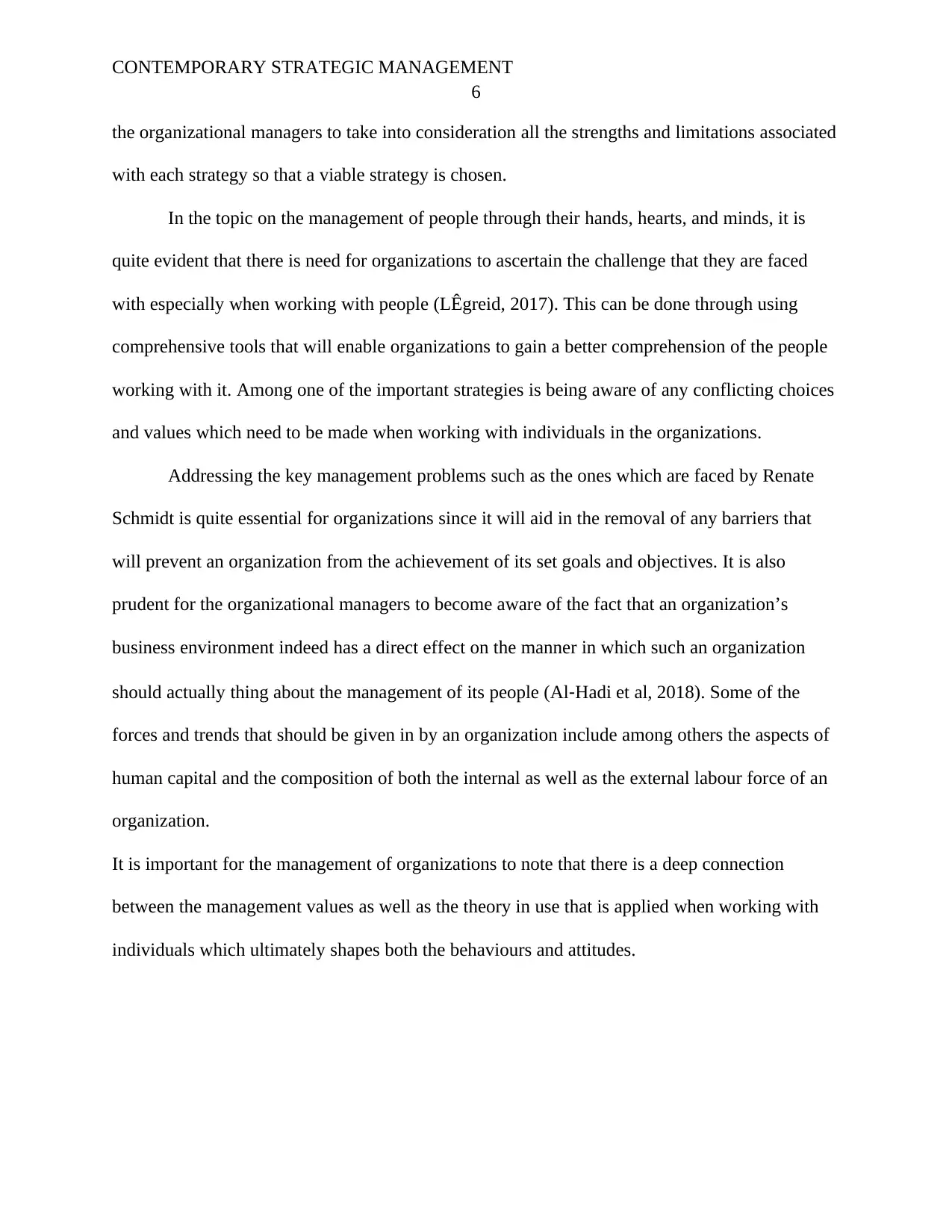
CONTEMPORARY STRATEGIC MANAGEMENT
6
the organizational managers to take into consideration all the strengths and limitations associated
with each strategy so that a viable strategy is chosen.
In the topic on the management of people through their hands, hearts, and minds, it is
quite evident that there is need for organizations to ascertain the challenge that they are faced
with especially when working with people (LÊgreid, 2017). This can be done through using
comprehensive tools that will enable organizations to gain a better comprehension of the people
working with it. Among one of the important strategies is being aware of any conflicting choices
and values which need to be made when working with individuals in the organizations.
Addressing the key management problems such as the ones which are faced by Renate
Schmidt is quite essential for organizations since it will aid in the removal of any barriers that
will prevent an organization from the achievement of its set goals and objectives. It is also
prudent for the organizational managers to become aware of the fact that an organization’s
business environment indeed has a direct effect on the manner in which such an organization
should actually thing about the management of its people (Al‐Hadi et al, 2018). Some of the
forces and trends that should be given in by an organization include among others the aspects of
human capital and the composition of both the internal as well as the external labour force of an
organization.
It is important for the management of organizations to note that there is a deep connection
between the management values as well as the theory in use that is applied when working with
individuals which ultimately shapes both the behaviours and attitudes.
6
the organizational managers to take into consideration all the strengths and limitations associated
with each strategy so that a viable strategy is chosen.
In the topic on the management of people through their hands, hearts, and minds, it is
quite evident that there is need for organizations to ascertain the challenge that they are faced
with especially when working with people (LÊgreid, 2017). This can be done through using
comprehensive tools that will enable organizations to gain a better comprehension of the people
working with it. Among one of the important strategies is being aware of any conflicting choices
and values which need to be made when working with individuals in the organizations.
Addressing the key management problems such as the ones which are faced by Renate
Schmidt is quite essential for organizations since it will aid in the removal of any barriers that
will prevent an organization from the achievement of its set goals and objectives. It is also
prudent for the organizational managers to become aware of the fact that an organization’s
business environment indeed has a direct effect on the manner in which such an organization
should actually thing about the management of its people (Al‐Hadi et al, 2018). Some of the
forces and trends that should be given in by an organization include among others the aspects of
human capital and the composition of both the internal as well as the external labour force of an
organization.
It is important for the management of organizations to note that there is a deep connection
between the management values as well as the theory in use that is applied when working with
individuals which ultimately shapes both the behaviours and attitudes.
⊘ This is a preview!⊘
Do you want full access?
Subscribe today to unlock all pages.

Trusted by 1+ million students worldwide
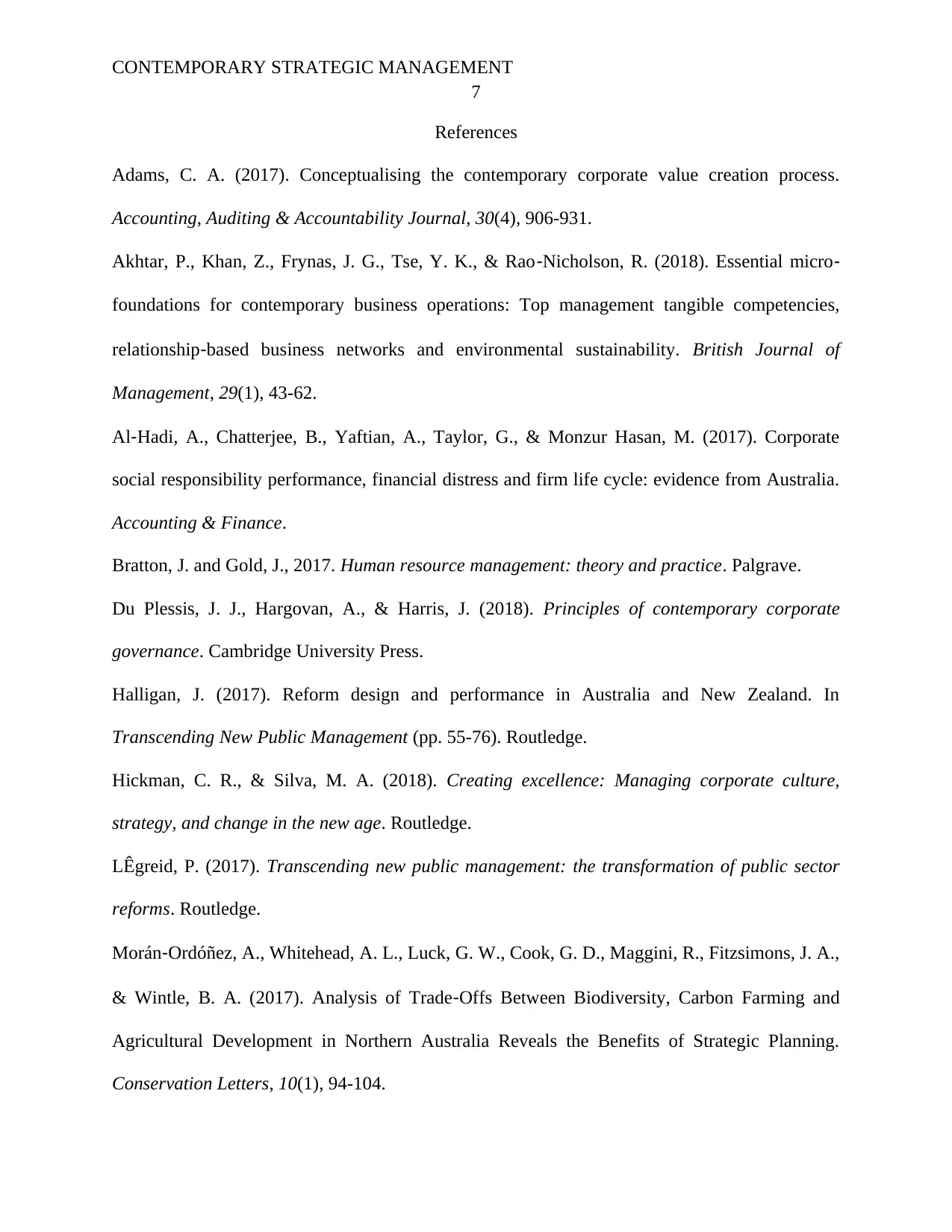
CONTEMPORARY STRATEGIC MANAGEMENT
7
References
Adams, C. A. (2017). Conceptualising the contemporary corporate value creation process.
Accounting, Auditing & Accountability Journal, 30(4), 906-931.
Akhtar, P., Khan, Z., Frynas, J. G., Tse, Y. K., & Rao‐Nicholson, R. (2018). Essential micro‐
foundations for contemporary business operations: Top management tangible competencies,
relationship‐based business networks and environmental sustainability. British Journal of
Management, 29(1), 43-62.
Al‐Hadi, A., Chatterjee, B., Yaftian, A., Taylor, G., & Monzur Hasan, M. (2017). Corporate
social responsibility performance, financial distress and firm life cycle: evidence from Australia.
Accounting & Finance.
Bratton, J. and Gold, J., 2017. Human resource management: theory and practice. Palgrave.
Du Plessis, J. J., Hargovan, A., & Harris, J. (2018). Principles of contemporary corporate
governance. Cambridge University Press.
Halligan, J. (2017). Reform design and performance in Australia and New Zealand. In
Transcending New Public Management (pp. 55-76). Routledge.
Hickman, C. R., & Silva, M. A. (2018). Creating excellence: Managing corporate culture,
strategy, and change in the new age. Routledge.
LÊgreid, P. (2017). Transcending new public management: the transformation of public sector
reforms. Routledge.
Morán‐Ordóñez, A., Whitehead, A. L., Luck, G. W., Cook, G. D., Maggini, R., Fitzsimons, J. A.,
& Wintle, B. A. (2017). Analysis of Trade‐Offs Between Biodiversity, Carbon Farming and
Agricultural Development in Northern Australia Reveals the Benefits of Strategic Planning.
Conservation Letters, 10(1), 94-104.
7
References
Adams, C. A. (2017). Conceptualising the contemporary corporate value creation process.
Accounting, Auditing & Accountability Journal, 30(4), 906-931.
Akhtar, P., Khan, Z., Frynas, J. G., Tse, Y. K., & Rao‐Nicholson, R. (2018). Essential micro‐
foundations for contemporary business operations: Top management tangible competencies,
relationship‐based business networks and environmental sustainability. British Journal of
Management, 29(1), 43-62.
Al‐Hadi, A., Chatterjee, B., Yaftian, A., Taylor, G., & Monzur Hasan, M. (2017). Corporate
social responsibility performance, financial distress and firm life cycle: evidence from Australia.
Accounting & Finance.
Bratton, J. and Gold, J., 2017. Human resource management: theory and practice. Palgrave.
Du Plessis, J. J., Hargovan, A., & Harris, J. (2018). Principles of contemporary corporate
governance. Cambridge University Press.
Halligan, J. (2017). Reform design and performance in Australia and New Zealand. In
Transcending New Public Management (pp. 55-76). Routledge.
Hickman, C. R., & Silva, M. A. (2018). Creating excellence: Managing corporate culture,
strategy, and change in the new age. Routledge.
LÊgreid, P. (2017). Transcending new public management: the transformation of public sector
reforms. Routledge.
Morán‐Ordóñez, A., Whitehead, A. L., Luck, G. W., Cook, G. D., Maggini, R., Fitzsimons, J. A.,
& Wintle, B. A. (2017). Analysis of Trade‐Offs Between Biodiversity, Carbon Farming and
Agricultural Development in Northern Australia Reveals the Benefits of Strategic Planning.
Conservation Letters, 10(1), 94-104.
Paraphrase This Document
Need a fresh take? Get an instant paraphrase of this document with our AI Paraphraser
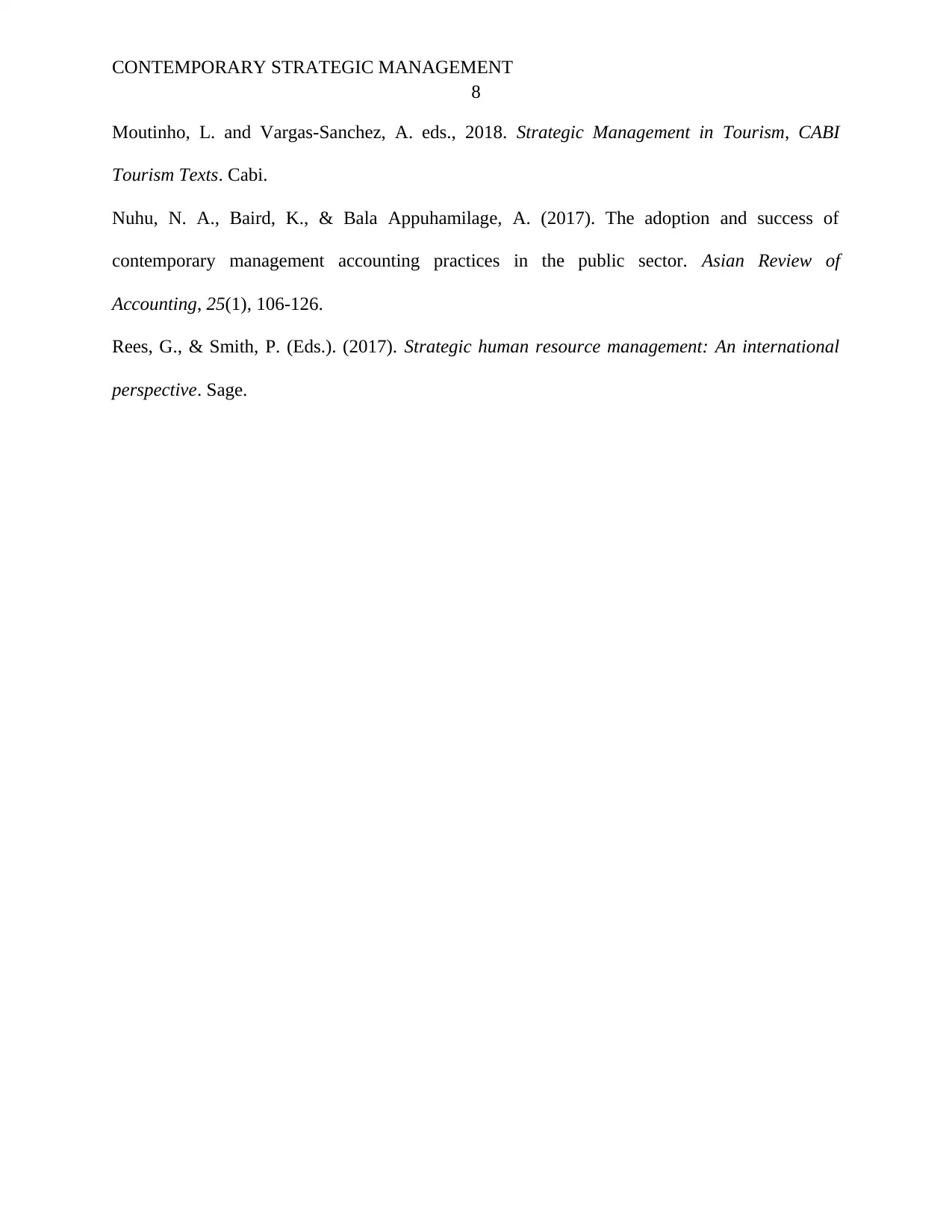
CONTEMPORARY STRATEGIC MANAGEMENT
8
Moutinho, L. and Vargas-Sanchez, A. eds., 2018. Strategic Management in Tourism, CABI
Tourism Texts. Cabi.
Nuhu, N. A., Baird, K., & Bala Appuhamilage, A. (2017). The adoption and success of
contemporary management accounting practices in the public sector. Asian Review of
Accounting, 25(1), 106-126.
Rees, G., & Smith, P. (Eds.). (2017). Strategic human resource management: An international
perspective. Sage.
8
Moutinho, L. and Vargas-Sanchez, A. eds., 2018. Strategic Management in Tourism, CABI
Tourism Texts. Cabi.
Nuhu, N. A., Baird, K., & Bala Appuhamilage, A. (2017). The adoption and success of
contemporary management accounting practices in the public sector. Asian Review of
Accounting, 25(1), 106-126.
Rees, G., & Smith, P. (Eds.). (2017). Strategic human resource management: An international
perspective. Sage.
1 out of 8
Related Documents
Your All-in-One AI-Powered Toolkit for Academic Success.
+13062052269
info@desklib.com
Available 24*7 on WhatsApp / Email
![[object Object]](/_next/static/media/star-bottom.7253800d.svg)
Unlock your academic potential
Copyright © 2020–2025 A2Z Services. All Rights Reserved. Developed and managed by ZUCOL.





